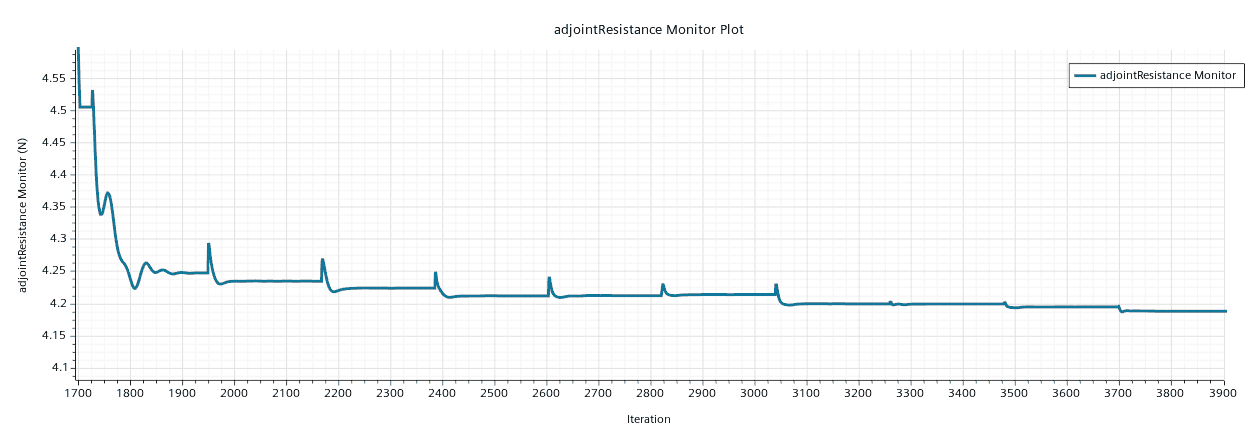Adjoint shape optimization using surface sensitivity is a powerful method for improving designs by deforming the mesh to optimize a user-defined cost function. This approach involves several key steps, including solving the primal flow, computing the adjoint solution, and morphing the surface mesh.
Requirements for Adjoint Simulation
To perform an adjoint simulation in Simcenter STAR-CCM+, several requirements must be met to ensure accuracy and robustness. Specifically, the primal solution must be a steady-state simulation, and the flow must be single-phase. These requirements typically disqualify the adjoint method for marine applications where the interaction of the hull with the free surface plays a crucial role. However, by integrating unsteady VOF simulations with the adjoint method in a single simulation file with the help of the new Stages concept in Simcenter STAR-CCM+, we can leverage the strengths of both techniques to optimize hull designs effectively.

Hybrid Approach
Combining unsteady VOF simulations with the adjoint method allows us to capture detailed wave interactions and efficiently compute gradients for optimization:
- Detailed Wave Interaction: The VOF simulation provides a comprehensive understanding of how the hull interacts with the water surface, capturing complex wave patterns that are critical for accurate resistance estimation.
- Efficient Optimization: The adjoint method offers an efficient way to compute the gradients needed for optimization, even in high-dimensional design spaces. This enables precise adjustments to the hull shape that directly target drag reduction.
Practical Implementation and Benefits
Implementing this hybrid approach involves several steps:
- Initial Hull Design: Start with an initial hull design and perform an unsteady VOF simulation to understand the wave patterns and identify areas of high resistance.
- Re–mesh: Re-mesh the hull and transform the motion coordinate system to position the hull for the primal adjoint simulation in a floating position.
- Iterate Adjoint: Iteratively adjust the hull shape based on the sensitivity analysis, continuously refining the design to achieve optimal performance.
- Primal Flow Simulation: Conduct a steady-state single-phase flow simulation to establish a baseline for fluid flow around the hull.
- Adjoint Sensitivity Analysis: Apply the adjoint method to compute the surface sensitivity and determine the impact of potential shape changes on hull resistance.
- Update wave patter: Perform an unsteady VOF simulation with the optimized hull shape.
Test case
For our test case, we use the Japan Bulk Carrier (JBC) ship. The optimization process involves using surface sensitivity calculated from the adjoint method, combined with the Morph Surface Mesh operation to adjust the two highlighted patches on the hull. The adjoint cost function is the sum of pressure and shear forces on the hull.

To automate the workflow, we set up Simulation operations in Simcenter STAR-CCM+, utilizing the Stages concept to manage different physics stages. This involves two stages to activate unsteady VOF and steady-state adjoint simulations, and an additional stage for the 6-DOF solver, ensuring smooth transitions between different simulation setups. The solver will be available in both physics stages, yet it conflicts with the steady-state set op of the adjoint stage. The bypass an error, we need to stage the “Solver frozen” option.


Note: We must initialize all continua at the start before running the physics simulations to avoid conflicts
Results and Observations
From the adjoint cost function plot, it is evident that the mesh morphing reduces the cost function in several steps, as defined in the optimization loop. Comparing the optimized hull shape with the initial geometry, we observe deformations on both defined surface patches, aiming to widen the bow and aft shoulder while narrowing the stern.


The total resistance of the free surface simulation drops significantly after the adjoint optimization.

Combined Optimization
Being able to combine the unsteady resistance calculation, including the motion of the ship, with the effective shape optimization, allows to run even more effective optimizations of the hull shape. Here we test the optimization of the bulb height, with only one parameter. This ensures a fast convergence of the optimization and thanks to the surface sensitivity, an optimal combination of underwater hull shape and interaction with the free surface.

The Design Manager use the SHERPA algorithm to find the best bulb position. The objective function is the combination of the unsteady pressure resistance and the total steady-state resistance from the optimized hull.

The benefits of this approach are significant:
- Reduced Drag: By optimizing the hull shape, particularly the bulbous bow, we can significantly reduce underwater drag, leading to lower fuel consumption and operational costs.
- Minimized Wave Resistance: Optimizing the hull to interact more efficiently with the water surface reduces wave resistance, enhancing the ship’s overall performance.
- Environmental Impact: Improved hull efficiency translates to lower emissions, contributing to more sustainable maritime operations.
Conclusion
The integration of unsteady VOF simulations with steady-state adjoint method analyses represents a powerful toolset for optimizing ship hull designs. This innovative approach not only reduces drag and wave resistance but also paves the way for more sustainable and cost-effective maritime transportation.
At Volupe, we’re committed to pushing the boundaries of what’s possible in ship design. Stay tuned to our blog for more and feel free to contact us at support@volupe.com.
The Author
Florian Vesting, PhD
Contact: support@volupe.com
+46 768 51 23 46
